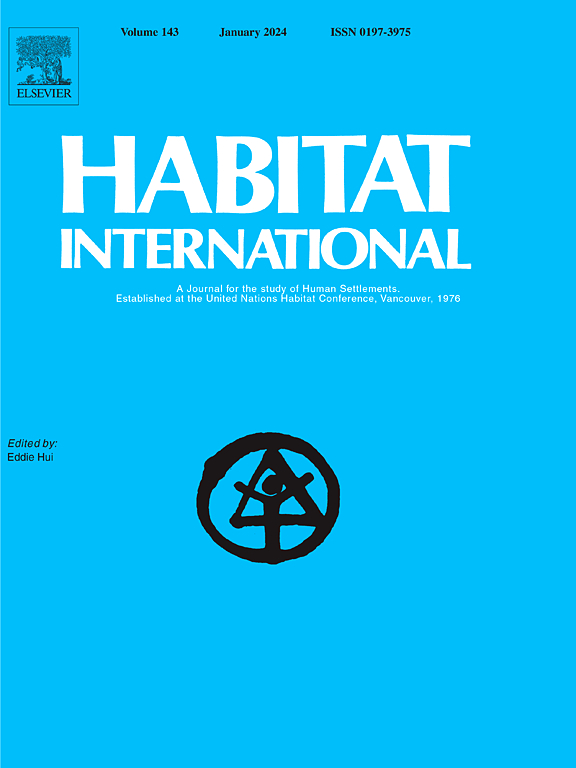从可持续性和社会公平的角度衡量城乡一体化:来自中国的证据
IF 7
1区 经济学
Q1 DEVELOPMENT STUDIES
引用次数: 0
摘要
世界范围内快速的城市化和工业化加剧了城乡差距,使资源和人口向城市转移,削弱了农村社区。全球可持续发展议程明确要求加强城乡联系,以弥合这些差距。在中国,决策者最近将城乡一体化提升到了国家“乡村振兴”战略的高度,反映出他们认识到长期增长需要平衡城乡发展和确保社会公平。尽管高层做出了承诺,但评估整合和指导实践的经验工具仍然不发达。通过对401名城乡一体化专家的调查,构建了经济发展平衡、社会福利公平和环境治理一致性三个维度的指标体系。探索性和验证性因素分析提炼出六个关键因素:环境治理、经济结构、社会保障、公共服务、社会平等和经济效率。研究结果强调,有效的土地利用、包容性的社会保障和社会心理健康等因素对一体化进程至关重要。值得注意的是,社会保障和公共服务因素的突出反映了最近统一农民工社会保险和城乡基本服务均等化的政策目标。通过18个城乡一体化示范区的案例数据,进一步验证了该框架的专业严谨性和实用性。总体而言,拟议的框架强调了城乡一体化发展如何推进中国的可持续发展目标和社会公平议程。通过将经济、社会和环境指标联系起来,它为监测可持续发展目标和共同繁荣的进展提供了一个系统的工具。这项工作通过社会公平的视角构建城乡一体化,填补了理论空白,并为政策制定者提供了包容性城市化的指导。根据这些发现,政策干预应针对关键领域,如农村住房、公共服务、数字基础设施、土地转让机制和农村人才。本文章由计算机程序翻译,如有差异,请以英文原文为准。
Measuring urban–rural integration through the lenses of sustainability and social equity: Evidence from China
Rapid urbanization and industrialization worldwide have intensified urban-rural disparities, drawing resources and populations into cities and weakening rural communities. The global sustainable development agenda explicitly calls for stronger urban–rural linkages to bridge these gaps. In China, policymakers have recently elevated urban-rural integration in the national “rural revitalization” strategy, reflecting a recognition that long-term growth requires balancing urban and rural progress and ensuring social equity. Despite high-level commitment, empirical tools to evaluate integration and guide practice remain underdeveloped. A survey of 401 experts in urban–rural integration was used to develop an indicator system under three dimensions: economic development balance, social welfare equity and environmental governance coherence. Exploratory and confirmatory factor analyses distilled six key factors: environmental governance, economic structure, social security, public services, social equality, and economic efficiency. The results highlight that factors such as efficient land use, inclusive social security and psychosocial well-being are critical to the integration process. Notably, the prominence of social security and public service factors echoes recent policy goals of unifying social insurance for migrant workers and equalizing basic services across urban and rural areas. The framework was further validated using case data from 18 designated urban–rural integration demonstration zones, confirming its professional rigor and practical applicability. Overall, the proposed framework underscores how integrated rural–urban development advances China's sustainable development goals (SDGs) and social equity agenda. By linking economic, social and environmental indicators, it provides a systematic tool to monitor progress toward SDGs and common prosperity. This work fills a theoretical gap by framing urban–rural integration through a social-fairness lens and offers policymakers guidance on inclusive urbanization. In line with these findings, policy interventions should target key areas, such as rural housing, public services, digital infrastructure, land transfer mechanisms, and rural talent.
求助全文
通过发布文献求助,成功后即可免费获取论文全文。
去求助
来源期刊

Habitat International
Multiple-
CiteScore
10.50
自引率
10.30%
发文量
151
审稿时长
38 days
期刊介绍:
Habitat International is dedicated to the study of urban and rural human settlements: their planning, design, production and management. Its main focus is on urbanisation in its broadest sense in the developing world. However, increasingly the interrelationships and linkages between cities and towns in the developing and developed worlds are becoming apparent and solutions to the problems that result are urgently required. The economic, social, technological and political systems of the world are intertwined and changes in one region almost always affect other regions.
 求助内容:
求助内容: 应助结果提醒方式:
应助结果提醒方式:


